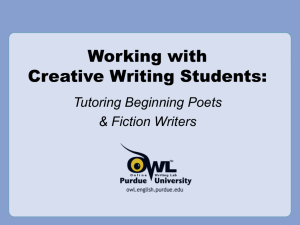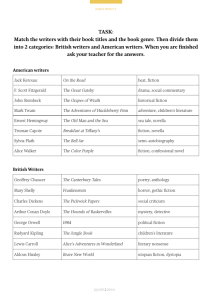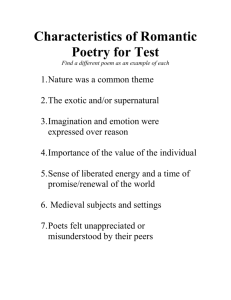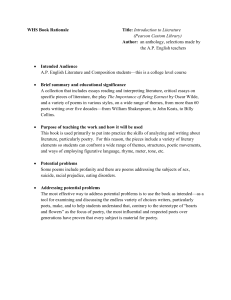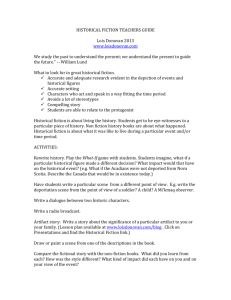Working with Creative Writing Students: Tutoring Beginning
advertisement
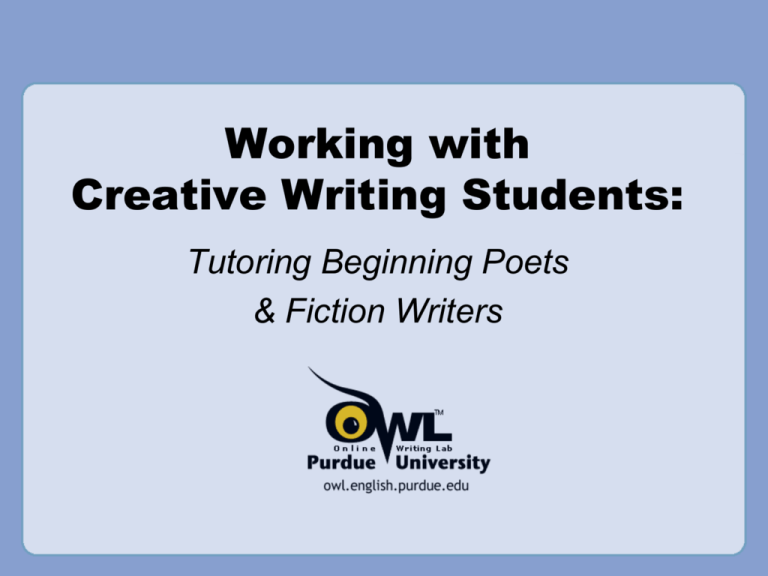
Working with Creative Writing Students: Tutoring Beginning Poets & Fiction Writers Overview This presentation will describe… • • • • • The typical writing workshop Common pitfalls for beginning poets Common pitfalls for beginning fiction writers Tactics for tutoring beginning creative writers Advice for creative writers The Typical Writing Workshop • Covers poetry and fiction in one semester • Introduces students to contemporary authors • Teaches students to read as writers rather than literary critics • Focuses on elements of craft – Poetry: language, line break, form, image – Fiction: narration, scene, character, setting Creative Writing Students • • • • • May or may not be English majors May or may not be aspiring poets or novelists Have usually not yet experienced a workshop Have read little or no contemporary poetry Have read few contemporary short stories The Beginning Poet’s Pitfalls • • • • Uses abstraction more than image Falls back on clichés Stays focused on only one subject Is often sentimental about his/her subject Image vs. Abstraction Beginning poets often… • Still believe that poetry must be “deep,” mysterious, and difficult • Favor abstract words like ‘despair,’ ‘pain,’ ‘heaven’ or ‘evil’ – These words are loaded but too general Image vs. Abstraction What to tell them: Specificity = universality. Generality = cliché • Concrete images involve a reader’s senses • Images are more unique to the writer and his/her own particular experience Reliance on Clichés Clichés… • Hold truth, but have little impact on the reader • Are often placeholders for something the student can’t yet express well • Are general and impersonal Reliance on Clichés Examples of “poetic” clichés: • The lake was a mirror. • Her skin was like porcelain. • The sunset looked like fire. These are descriptive, but aren’t very surprising or new. Reliance on Clichés Try altering the language or getting more specific. Cliché: The lake was a mirror. Possible revisions: The lake mirrored the mountains. The lake was a bowl of sky. Reliance on Clichés Other ways to help: • Brainstorm images to replace abstractions – What color, object, or image evokes ‘despair’? • Talk about the emotion or story behind the poem • Examine the ‘placeholders’ – What were they really getting at there? Leaving the Triggering Subject Beginning poets often get stuck. They may… • Describe one thing in detail, then stop. • Write poems that leave you with a “so what?” feeling • Still be searching for subjects that deeply interest them Leaving the Triggering Subject Richard Hugo’s two poetic subjects: • Triggering subject – what got the writer started • Found subject – what the writer discovered as s/he wrote Encourage poets to free associate subjects, images, and ideas as they write. Free Association Example Say a student writes a poem about “autumn rain.” Ask questions: • What memories does this subject call up for the speaker in the poem? • How is autumn rain different from summer rain, spring rain, etc? • What does it look, feel, taste, or smell like? Avoiding Sentimentality Beginning poets often rely on sentimental language. They may… • Write about personal experiences • Write about family or significant others • Write the equivalent of a greeting card (with seemingly genuine feeling that could apply to almost anyone) Avoiding Sentimentality Emotion = good. Sappy = bad. Encourage students to… • Explore emotion through image • Let emotions be complex, even ambivalent • Steer clear of subjects still ‘too close to the bone’ The Beginning Fiction Writer • Writes more summary/synopsis than scene • Leaves out important detail/description • Tries to convey a moral at the story’s end • Mimics a favorite author too closely – May recycle their plots or subjects – May use language that feels ‘not their own’ Summary vs. Scene • Summary “tells” and moves quickly through information – Background information • Scene “shows” and takes place in realtime, like a movie – Important interactions and events Summary vs. Scene Encourage students to… • Jump into the middle of the action • Capture the reader’s attention in the very first paragraph • Introduce the main character right away Important Detail Beginning fiction writers may neglect to… • Fully describe characters as they enter the story • Give enough description of the setting • Break up dialogue with gestures or other details Encourage students to slow down and describe. Important Detail Beginning fiction writers often use “the police rundown” to describe characters. Examples: He was six feet tall with brown hair and blue eyes. She was so beautiful she could have been a model. Character Description Physical description + gesture = better characters Possible Revisions: She had long brown hair that constantly fell in her face. She was always tucking it behind her ears. He often massaged the wrinkle between his eyebrows when he was worried or tired. Summing Up with a Moral These stories may suffer from… • Stereotyped characters • Predictable plots • That ‘after school special’ feel Summing Up with a Moral Remind students that writing with a moral in mind… • constricts action and character development • limits their audience The most compelling moments in life are rarely ‘black and white’ Working with Writerly Role Models Encourage students to… • Articulate what they admire about their favorite author’s work • Consider what new perspective they might have on the author’s subjects • Find their own voice, style, and subject matter General Advice to Avoid Don’t advise students… • To write only what they know • To write about difficult personal situations • To show work to their roommates or family members Advice to Give Do tell students… • • • • What inspired a reaction in you as a reader To read, read, and read some more To find writers whose work they admire To write what they see, hear, taste, touch, and smell in every scene or poem Need More? • Find more handouts on teaching creative writing on Purdue’s OWL – http://owl.english.purdue.edu/owl • Ask the creative writing faculty at your school for more advice The End
